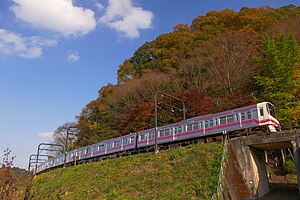| This article needs additional citations for verification. Please help improve this article by adding citations to reliable sources. Unsourced material may be challenged and removed. Find sources: "Keiō Takao Line" – news · newspapers · books · scholar · JSTOR (October 2016) (Learn how and when to remove this message) |
| Keiō Takao Line | |||||||||||||||||||||||||||||||||||||||||||||||||||||||||||||||||||||||||||||||||||||||||||||||||||||||||||||||||||||
|---|---|---|---|---|---|---|---|---|---|---|---|---|---|---|---|---|---|---|---|---|---|---|---|---|---|---|---|---|---|---|---|---|---|---|---|---|---|---|---|---|---|---|---|---|---|---|---|---|---|---|---|---|---|---|---|---|---|---|---|---|---|---|---|---|---|---|---|---|---|---|---|---|---|---|---|---|---|---|---|---|---|---|---|---|---|---|---|---|---|---|---|---|---|---|---|---|---|---|---|---|---|---|---|---|---|---|---|---|---|---|---|---|---|---|---|---|---|
 | |||||||||||||||||||||||||||||||||||||||||||||||||||||||||||||||||||||||||||||||||||||||||||||||||||||||||||||||||||||
 An 8000 series EMU train on the Takao Line in November 2021 An 8000 series EMU train on the Takao Line in November 2021 | |||||||||||||||||||||||||||||||||||||||||||||||||||||||||||||||||||||||||||||||||||||||||||||||||||||||||||||||||||||
| Overview | |||||||||||||||||||||||||||||||||||||||||||||||||||||||||||||||||||||||||||||||||||||||||||||||||||||||||||||||||||||
| Native name | 京王高尾線 | ||||||||||||||||||||||||||||||||||||||||||||||||||||||||||||||||||||||||||||||||||||||||||||||||||||||||||||||||||||
| Owner | Keio Corporation | ||||||||||||||||||||||||||||||||||||||||||||||||||||||||||||||||||||||||||||||||||||||||||||||||||||||||||||||||||||
| Locale | Tokyo | ||||||||||||||||||||||||||||||||||||||||||||||||||||||||||||||||||||||||||||||||||||||||||||||||||||||||||||||||||||
| Termini | |||||||||||||||||||||||||||||||||||||||||||||||||||||||||||||||||||||||||||||||||||||||||||||||||||||||||||||||||||||
| Stations | 7 | ||||||||||||||||||||||||||||||||||||||||||||||||||||||||||||||||||||||||||||||||||||||||||||||||||||||||||||||||||||
| Service | |||||||||||||||||||||||||||||||||||||||||||||||||||||||||||||||||||||||||||||||||||||||||||||||||||||||||||||||||||||
| Type | Commuter rail | ||||||||||||||||||||||||||||||||||||||||||||||||||||||||||||||||||||||||||||||||||||||||||||||||||||||||||||||||||||
| Rolling stock | Keio 5000 series Keio 7000 series Keio 8000 series Keio 9000 series | ||||||||||||||||||||||||||||||||||||||||||||||||||||||||||||||||||||||||||||||||||||||||||||||||||||||||||||||||||||
| History | |||||||||||||||||||||||||||||||||||||||||||||||||||||||||||||||||||||||||||||||||||||||||||||||||||||||||||||||||||||
| Opened | 1 October 1967; 57 years ago (1967-10-01) | ||||||||||||||||||||||||||||||||||||||||||||||||||||||||||||||||||||||||||||||||||||||||||||||||||||||||||||||||||||
| Technical | |||||||||||||||||||||||||||||||||||||||||||||||||||||||||||||||||||||||||||||||||||||||||||||||||||||||||||||||||||||
| Line length | 8.6 km (5.3 mi) | ||||||||||||||||||||||||||||||||||||||||||||||||||||||||||||||||||||||||||||||||||||||||||||||||||||||||||||||||||||
| Track gauge | 1,372 mm (4 ft 6 in) | ||||||||||||||||||||||||||||||||||||||||||||||||||||||||||||||||||||||||||||||||||||||||||||||||||||||||||||||||||||
| Minimum radius | 200 m (660 ft) | ||||||||||||||||||||||||||||||||||||||||||||||||||||||||||||||||||||||||||||||||||||||||||||||||||||||||||||||||||||
| Electrification | 1,500 V DC (overhead catenary) | ||||||||||||||||||||||||||||||||||||||||||||||||||||||||||||||||||||||||||||||||||||||||||||||||||||||||||||||||||||
| Operating speed | 105 km/h (65 mph) | ||||||||||||||||||||||||||||||||||||||||||||||||||||||||||||||||||||||||||||||||||||||||||||||||||||||||||||||||||||
| Train protection system | Keio ATC | ||||||||||||||||||||||||||||||||||||||||||||||||||||||||||||||||||||||||||||||||||||||||||||||||||||||||||||||||||||
| Maximum incline | 3.5% | ||||||||||||||||||||||||||||||||||||||||||||||||||||||||||||||||||||||||||||||||||||||||||||||||||||||||||||||||||||
| |||||||||||||||||||||||||||||||||||||||||||||||||||||||||||||||||||||||||||||||||||||||||||||||||||||||||||||||||||||
The Keiō Takao line (京王高尾線, Keiō Takao-sen) is a railway line operated by the Japanese private railway operator Keio Corporation. The line connects Kitano Station on the Keio Line, to Takaosanguchi Station, and offers access to Mount Takao at the terminal. It is 1,372 mm (4 ft 6 in) gauge, electrified at 1,500 V DC. The line originally terminated at Goryōmae to service visitors to the Musashi Imperial Graveyard.
During the daytime, most trains operate through to/from the Shinjuku terminal on the Keio Line.
Service patterns
On the Takao Line, Keio operates six different service types, with trains running through to and from the Keio Main Line.
- Local (各駅停車, Kakueki Teisha) (L)
- Rapid (快速, Kaisoku) (R)
- Semi Express (区間急行, Kukan Kyūkō) (SeE)
- Express (急行, Kyūkō) (E)
- Special Express (特急, Tokkyū) (SpE)
- Mt.TAKAO (MT) - Reserved-seat supplementary-fare services to and from Shinjuku, operating on weekends and holidays with three round-trips.
Stations
All stations are in Hachiōji, Tokyo.
- Legend
● : All trains stop
▲ : Shinjuku-bound trains stop to pick up passengers
│ : All trains pass
| No. | Station | Japanese | Distance (km) (from Kitano) | Distance (km) (from Shinjuku) | L | R | SeE | E | SpE | MT | Transfers |
|---|---|---|---|---|---|---|---|---|---|---|---|
| ↑ Through-running to/from the KOKeio Line towards Shinjuku ↑ | |||||||||||
| KO33 | Kitano | 北野 | 0.0 | 36.1 | ● | ● | ● | ● | ● | ▲ | |
| KO48 | Keiō-Katakura | 京王片倉 | 1.7 | 37.8 | ● | ● | ● | | | ● | | | JH Yokohama Line |
| KO49 | Yamada | 山田 | 3.2 | 39.3 | ● | ● | ● | | | ● | | | |
| KO50 | Mejirodai | めじろ台 | 4.3 | 40.4 | ● | ● | ● | ● | ● | ▲ | |
| KO51 | Hazama | 狭間 | 5.8 | 41.9 | ● | ● | ● | | | ● | | | |
| KO52 | Takao | 高尾 | 6.9 | 43.0 | ● | ● | ● | ● | ● | ▲ | JC Chuo Line (Rapid) |
| KO53 | Takaosanguchi | 高尾山口 | 8.6 | 44.7 | ● | ● | ● | ● | ● | ● | |
History
Former Goryō Line
On March 20, 1930, the Keio Electric Tramway opened the Goryō Line, a 6.3 km branch of the Keio Line, electrified at 600 V DC, between Kitano Station and Goryōmae Station. The terminus, Goryōmae, was a gateway for the tomb of Emperor Taishō.
The line had three intermediate stations: Katakura, Yamada, and Yokoyama. Yokoyama Station and Goryōmae Station were renamed Musashi-Yokoyama Station and Tamagoryōmae Station respectively in 1937. The line was single track and had a passing loop at Yokoyama Station. On weekdays, the line operated at 30 or 40 minute intervals, while at weekends it operated through trains to Yotsuya-Shinjuku Station, the Tokyo terminal of Keio at that time, at 20-minute intervals.
The Keio Electric Tramway was merged into Tokyō Kyūko Dentetsu (present-day Tokyu Corporation) in 1944. The new operator suspended operation of the Goryō Line on January 21, 1945, as a "not needed or not pressing" line, which was subject of the collection of metal for the war effort.
In 1948, Keio Teito Electric Railway (present-day Keio Corporation) was established and succeeded the former operation of Keiō Electric Tramway including the suspended Goryō Line.
Takao Line
During the economic boom in the 1960s, Keio decided to build a new line to Mount Takao, utilizing a part of the (effectively closed) Goryō Line. Keio opened the Takao Line on October 1, 1967, electrified at 1,500 V DC and dual track to Takao station. Of the former Goryō Line stations, Katakura Station (newly named Keiō-Katakura Station) and Yamada Station were revived.
References
This article incorporates material from the corresponding article in the Japanese Misplaced Pages.
- ^ Terada, Hirokazu (July 2002). データブック日本の私鉄 [Databook: Private Railways of Japan]. Tokyo, Japan: Neko Publishing. pp. 62–63. ISBN 4-87366-874-3.
- https://www.keio.co.jp/train/map/pdf/rosenzu.pdf
- Iijima, Masashi (July 2003). "Musashi Chūō Denki Tetsudō to Goryōsen ni tsuite". The Railway Pictorial (in Japanese). 734 (July 2003 Extra). Tokyo: Denkisha Kenkyūkai: 127.
External links
- Keio Corporation website (in English)
| Keiō lines (1372mm, 4 ft 6 in) | |
|---|---|
| Keiō lines (1067mm, 3 ft 6 in) | |
| Related line | |
| Major stations | |